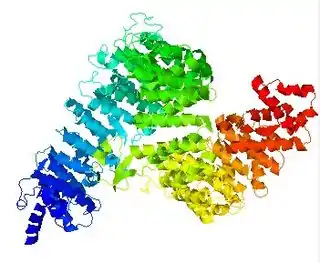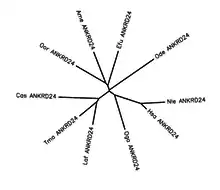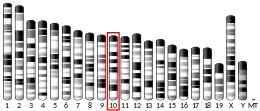ANKRD24
Ankyrin repeat domain-containing protein 24 is a protein in humans that is coded for by the ANKRD24 gene.[6] The gene is also known as KIAA1981[7]. The protein's function in humans is currently unknown. ANKRD24 is in the protein family that contains ankyrin-repeat domains.
| ANKRD24 | |||||||||||||||||||||||||||||||||||||||||||||||||||
|---|---|---|---|---|---|---|---|---|---|---|---|---|---|---|---|---|---|---|---|---|---|---|---|---|---|---|---|---|---|---|---|---|---|---|---|---|---|---|---|---|---|---|---|---|---|---|---|---|---|---|---|
| Identifiers | |||||||||||||||||||||||||||||||||||||||||||||||||||
| Aliases | ANKRD24, ankyrin repeat domain 24 | ||||||||||||||||||||||||||||||||||||||||||||||||||
| External IDs | MGI: 1890394 HomoloGene: 49885 GeneCards: ANKRD24 | ||||||||||||||||||||||||||||||||||||||||||||||||||
| |||||||||||||||||||||||||||||||||||||||||||||||||||
| |||||||||||||||||||||||||||||||||||||||||||||||||||
| |||||||||||||||||||||||||||||||||||||||||||||||||||
| |||||||||||||||||||||||||||||||||||||||||||||||||||
| Wikidata | |||||||||||||||||||||||||||||||||||||||||||||||||||
| |||||||||||||||||||||||||||||||||||||||||||||||||||

Gene
Locus

The gene is located on chromosome 19 at p13.3 on the forward strand.[10][11] The gene is 4041 base pairs in length and contains 29 exons.[9][12] The gene is neighbored by the gene SIRT6 that encodes for the Sirtuin-6 protein and the EBI3 gene that encodes for the Epstein-Barr virus induced gene 3 protein.[13]
Expression
The expression pattern of ANKRD24 is uncharacterized. Under conditions of cell growth and proliferation, the expression levels increase. In germ line tumors, glioma, and prostate cancer, the expression is elevated relative to other disease states. During development, the expression level is elevated in the blastocyst stage. In adults, there are elevated levels of expression in the placenta, stomach, kidneys, and eye relative to other tissues.[14] However, the results of experimental gene expression profiles are inconsistent relative to ANKRD24 expression, suggesting redundancy of the gene and its protein product.
mRNA
Alternative expression
13 transcription splice variants of ANKRD24 mRNA have been predicted.[15]
Protein
General features
The ANKRD24 protein is 1146 amino acids in length, has a molecular weight of 124kDa, and has an isoelectric point of 4.98.[16] The secondary structure is predicted to consist of all alpha helices and to not contain any beta strands.[17] The tertiary structure of the protein is predicted to be a helical twist.[5]
Composition
ANKRD24 has a relatively high composition of alanine (15.0%), glutamic acid (13.5%), and leucine (11.0%) and a relatively low composition of cysteine (1.5%), phenylalanine (0.7%), tryptophan (0.2%), and tyrosine (0.8%). The protein contains positive run clusters that could be nuclear localization signals. The protein does not have any significant negative charge clusters and no significant charge patterns.[18]
Domains
ANKRD24 is in the protein family that contains ankyrin-repeat domains. Ankyrin repeats are known for mediating protein-protein interactions.[20] The protein also contains two coiled-coil regions.[21]
Post-translational modification
ANKRD24 is predicted to undergo C-mannosylation.[22]
Interacting proteins
ANKRD24 is predicted to interact with disks large homolog 4 (DLG4), eukaryotic translation elongation factor 1-alpha 1 (EEF1A1), unc-119 homolog A (UNC119), replication timing regulatory factor 1 (RIF1), protein kinase C and casein kinase substrate in neurons 1 (PACSIN1), nuclear factor NF-kappa-B p105 subunit (NFKB1), cholest-5-ene-3β,7α-diol 3β-dehydrogenase (HSD3B7), lethal giant larvae homolog 2 (L2GL2), and glucocorticoid induced 1 (GLC)CI1.[23][24][25][26] No characterization of these interactions has yet to be observed.[27]
Homology

ANKRD24 has no human paralogs. Orthologous proteins are found in other organisms. The following table represents some of the orthologs found using searches in BLAST[29] and BLAT.[30] However, this list is not exhaustive for the orthologs of ANKRD24 and is only meant to display the wide diversity of species for which orthologs of ANKRD24 can be found.
| Genus species | Common Name | Date of Divergence (MYA)[31] | Accession # (Nucleotide) | Accession # (Protein) | Sequence Length (bp) | Sequence Length (aa) | E value | Sequence Identity (%) | Sequence Similarity (%) | |
| 1 | Homo sapiens | Humans | 0 | NM_133475.1 | NP_597732.1 | 4041 | 1146 | 100 | 100 | |
| 2 | Nomascus leucogenys | Northern white-cheeked gibbon | 19.9 | XM_012503370.1 | XP_012358824.1 | 3675 | 1165 | 0 | 95 | 96 |
| 3 | Otolemur garnettii | Small-eared galago | 75.9 | XM_012804592.1 | XP_012660046.1 | 4181 | 1035 | 0 | 83 | 87 |
| 4 | Trichechus manatus latirostris | Florida Manatee | 105 | XM_004378459.1 | ] | 3354 | 1117 | 0 | 81 | 86 |
| 5 | Eptesicus fuscus | Big brown bat | 97.5 | XM_008150610.1 | XP_008148832.1 | 3369 | 1122 | 0 | 80 | 84 |
| 6 | Ailuropoda melanoleuca | Giant panda | 97.5 | XM_002928471.2 | XP_002928517.1 | 3729 | 1116 | 0 | 80 | 84 |
| 7 | Loxodonta africana | African savanna elephant | 105 | XM_003421925.2 | XP_003421973.1 | 4049 | 1345 | 0 | 79 | 85 |
| 8 | Octodon degus | Degu | 90.9 | XM_004632746.1 | XP_004632803.1 | 3381 | 1126 | 0 | 79 | 84 |
| 9 | Chrysochloris asiatica | Cape golden mole | 105 | XM_006869037.1 | XP_006869099.1 | 3747 | 1248 | 0 | 78 | 85 |
| 10 | Orcinus orca | Killer Whale | 97.5 | XM_004277648.2 | XP_004277696.1 | 3482 | 1079 | 0 | 77 | 82 |
| 11 | Chelonia mydas | Green sea turle | 320.5 | XM_007072230.1 | XP_007072292 | 3051 | 1016 | 9.00E-178 | 63 | 77 |
| 12 | Ficedula albicollis | Collared flycatcher | 320.5 | XM_005060250.1 | XP_005060307 | 1885 | 621 | 2.00E-171 | 60 | 74 |
| 13 | Gekko Japonicus | Japanese gecko | 320.5 | XM_015410656.1 | XP_015266142 | 3057 | 1019 | 3.00E-175 | 58 | 75 |
| 14 | Python bivittatus | Burmese python | 320.5 | XM_007434390 | XP_007434452 | 3192 | 1063 | 1.00E-167 | 58 | 75 |
| 15 | Falco cherrug | Saker falcon | 320.5 | XM_014277718.1 | XP_014133193 | 1431 | 476 | 0 | 57 | 71 |
| 16 | Stegastes partitus | Bicolor damselfish | 429.6 | XM_008295305.1 | XP_008293527.1 | 3629 | 1095 | 2.00E-90 | 41 | 55 |
| 17 | Trichomonas vaginalis G3 | Trichomonas vaginalis | 2040 | XM_001329224.1 | XP_001329259 | 774 | 257 | 2.00E-24 | 34 | 54 |
| 18 | Ciona intestinalis | Vase tunicate | 733 | XM_009863371.1 | XP_009861673 | 3156 | 956 | 9.00E-24 | 32 | 48 |
| 19 | Talaromyces stipitatus | Fungi | 1302.5 | XM_002486774.1 | XP_002486819.1 | 3216 | 1071 | 3.00E-18 | 32 | 51 |
| 20 | Cryptococcus neoformans | Yeast | 1302.5 | XM_012197089.1 | XP_012052479.1 | 943 | 236 | 3.00E-16 | 32 | 51 |
References
- GRCh38: Ensembl release 89: ENSG00000089847 - Ensembl, May 2017
- GRCm38: Ensembl release 89: ENSMUSG00000054708 - Ensembl, May 2017
- "Human PubMed Reference:". National Center for Biotechnology Information, U.S. National Library of Medicine.
- "Mouse PubMed Reference:". National Center for Biotechnology Information, U.S. National Library of Medicine.
- "I-TASSER server for protein structure and function prediction". zhanglab.ccmb.med.umich.edu. Retrieved 2016-04-26.
- "ankyrin repeat domain-containing protein 24 [Homo sapiens] - Protein - NCBI". www.ncbi.nlm.nih.gov. Retrieved 2016-02-07.
- "ANKRD24 - Ankyrin repeat domain-containing protein 24 - Homo sapiens (Human) - ANKRD24 gene & protein". www.uniprot.org. Retrieved 2016-02-07.
- "Gene Card entry for ANKRD24". Gene Card. Retrieved 2016-05-09.
- "ANKRD24 ankyrin repeat domain 24 [Homo sapiens (human)] - Gene - NCBI". www.ncbi.nlm.nih.gov. Retrieved 2016-05-09.
- "Gene Card Entry on ANKRD24". www.genecards.org. Retrieved 2016-02-07.
- "Gene: ANKRD24 (ENSG00000089847) - Summary - Homo sapiens - Ensembl genome browser 84". useast.ensembl.org. Retrieved 2016-05-09.
- "Homo sapiens ankyrin repeat domain 24 (ANKRD24), mRNA - Nucleotide - NCBI". www.ncbi.nlm.nih.gov. Retrieved 2016-04-26.
- "ANKRD24 ankyrin repeat domain 24 [Homo sapiens (human)] - Gene - NCBI". www.ncbi.nlm.nih.gov. Retrieved 2016-04-27.
- "EST Profile - Hs.197872". www.ncbi.nlm.nih.gov. Retrieved 2016-04-27.
- "ankyrin repeat domain-containing protein 24 [Homo sapiens] - Protein - NCBI". www.ncbi.nlm.nih.gov. Retrieved 2016-04-24.
- "SDSC Biology Workbench". workbench.sdsc.edu. Retrieved 2016-05-09.
- "Phyre 2 Results for My_protein". www.sbg.bio.ic.ac.uk. Retrieved 2016-04-27.
- "SAPS submission on ANKRD24". Biology WorkBench.
- "Gene Card Entry on ANKRD24". www.genecards.org. Retrieved 2016-04-24.
- Mosavi LK, Cammett TJ, Desrosiers DC, Peng ZY (June 2004). "The ankyrin repeat as molecular architecture for protein recognition". Protein Science. 13 (6): 1435–48. doi:10.1110/ps.03554604. PMC 2279977. PMID 15152081.
- "ANKRD24 - Ankyrin repeat domain-containing protein 24 - Homo sapiens (Human) - ANKRD24 gene & protein". www.uniprot.org. Retrieved 2016-02-08.
- "NetCGlyc 1.0 Server". www.cbs.dtu.dk. Retrieved 2016-05-09.
- "8 binary interactions found for search term ANKRD24". IntAct Molecular Interaction Database. EMBL-EBI. Retrieved 2018-08-25.
- al., David Lynn et. "InnateDB: Systems Biology of the Innate Immune Response". www.innatedb.com. Retrieved 2016-04-24.
- "mentha: the interactome browser". mentha.uniroma2.it. Retrieved 2016-04-24.
- "mint database". mint.bio.uniroma2.it. Archived from the original on 2006-05-06. Retrieved 2016-04-24.
- "STRING: functional protein association networks". string-db.org. Retrieved 2016-02-08.
- "DRAWTREE". Biology WorkBench.
- "BLAST: Basic Local Alignment Search Tool". blast.ncbi.nlm.nih.gov. Retrieved 2016-05-09.
- "UCSC Genome Bioinformatics: FAQ". genome.ucsc.edu. Retrieved 2016-05-09.
- Hedges SB, Marin J, Suleski M, Paymer M, Kumar S (April 2015). "Tree of life reveals clock-like speciation and diversification". Molecular Biology and Evolution. 32 (4): 835–45. arXiv:1412.4312. doi:10.1093/molbev/msv037. PMC 4379413. PMID 25739733.



